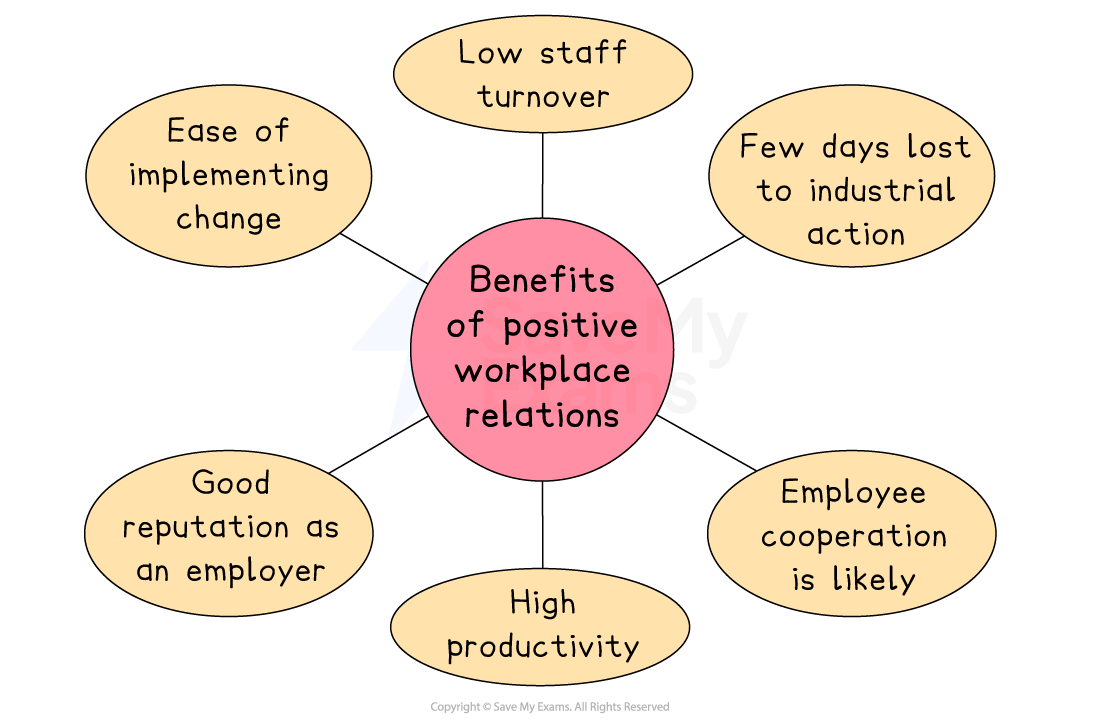Management and Workforce Relations (Cambridge (CIE) A Level Business): Revision Note
Exam code: 9609
Cooperation between management and the workforce
Workplace relations refers to the interactions between managers and workers in a business, including
How change is communicated and implemented
How grievances and disciplinary action are pursued
The level of consultation on key decisions
Fairness and effectiveness of business processes
Positive workplace relations between management and workers brings a range of benefits
Benefits of positive workplace relations

Low staff turnover
When workers have a positive relationship with their managers, they are less likely to leave or face dismissal
Few days lost to industrial action
Industrial action is where trade union members, in dispute with management, protest or take action, such as strikes, to achieve their aims
Effective workplace relations mean that disruption as a result of industrial action is unlikely
Employee cooperation
Employees may 'go the extra mile' for the business if they feel valued
Support from employees for key decisions means that objectives are more likely to be met
High productivity
Good working relationships mean workers are less likely to be absent from work and more likely to be focused on maximising output
Workers are more likely to contribute ideas that lead to improved performance
Good reputation as an employer
Businesses with good relationships avoid negative publicity
These businesses attract and retain the best staff
Ease of implementing change
Significant change is more likely to be welcomed rather than feared
Employees look to play their part in implementing change
Employee morale and welfare
Some businesses make great efforts to improve employees' welfare
Looking after workers is likely to lead to long-term loyalty and high levels of motivation, which can have a positive impact on labour productivity
Strategies to improve welfare
Strategy | Explanation |
|---|---|
Equality and diversity |
|
Provision of facilities |
|
Wellbeing policies |
|
Perks |
|
Work-life balance
Ensuring employees have a healthy work-life balance can lead to several advantages
Less stress-related absence lowers business costs and reduces disruption to production
Increased employee output, as when they are at work, their focus is likely to be improved
A more diverse workforce that has time to enjoy leisure and creative activities outside of working hours
Ways to improve work-life balance
Teleworking | Flexible working |
|---|---|
|
|
Job sharing | Sabbaticals |
|
|
Examiner Tips and Tricks
Flexible working may appear to offer benefits that are largely focused on the employee
In the exam, you could be asked to analyse the impact on a business of flexible working
You should focus your answer on improved employee motivation and productivity, as well as the ability to attract a larger number of candidates to advertised job roles
The impact on employers and employees of trade union involvement in the workplace
A trade union is an organisation whose members come together to achieve common goals
Union members pay a membership fee and elect representatives in the workplace
They negotiate with employers to improve terms and conditions of employment for workers
Improved pay
Increases in paid holidays
Reduced hours of work
Sufficient rest breaks
Improved training and development
Better facilities
Trade unions can also give individual advice when employees have a problem at work
They also lobby governments to pass laws that favour employees, such as improved health and safety regulations
Examples of trade unions
 |
|
 | IG Metall
|
 | Unión General de Trabajadores (UGT)
|
Trade unions can use a range of approaches to resolve conflict in the workplace. These include:
Collective bargaining
Work-to-rule
Strike action
Collective bargaining
A process where trade unions negotiate with employers to reach agreements on terms and conditions of employment
It is a structured way for employers and employees to come to a mutually acceptable agreement
Trade unions have greater negotiating power than individual employees
Negotiations typically cover a range of issues, including wages, working hours, benefits and workplace conditions
The collective bargaining process

The goal of collective bargaining is to reach a collective bargaining agreement
This is a legally binding document that determines the employment relationship for a specified period
Both parties must adhere to the terms of the agreement
If further disputes arise, tools such as mediation and arbitration can be used
Other forms of industrial action
Industrial action | Explanation | Example |
|---|---|---|
Work-to-rule |
|
|
Strike action |
|
|

Unlock more, it's free!
Did this page help you?